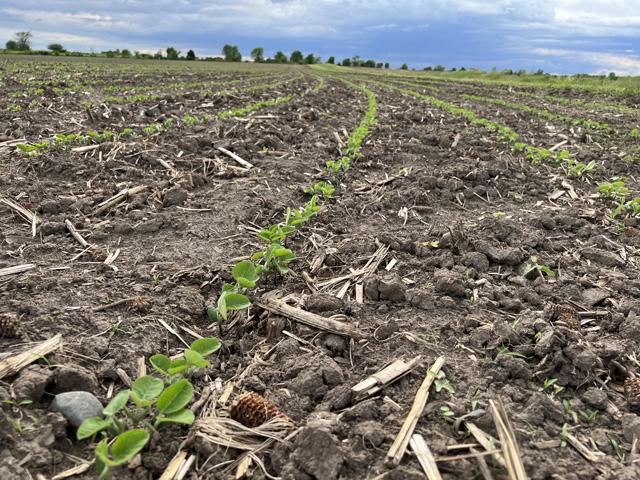Early Bean Tactics
Five Tips for Early Soybean Planting
DECATUR, Ill. (DTN) -- The early soybean planting craze doesn't seem nearly as crazed these days. Yield benefits to the practice are well established, and spring weather cooperates most years.
Still, AJ Woodyard, agronomist with Advanced Agrilytics, who also farms near Paris, Illinois, urges those interested in trying early beans to consider the following management decisions before planting seed into colder soils.
1. Seedbed preparation -- The most obvious risk with earlier planting dates is the higher chance of experiencing a freeze post-emergence. Varieties planted in March or early April will typically stay viable underground until conditions are right for emergence. However, soybeans that have already emerged are more susceptible when temperatures dip below freezing for extended periods of time.
"Soybeans that have emerged in tilled ground have a higher likelihood of tolerating cold snaps, thanks to warmer ground temperatures around that emerged seedling," said Woodyard. "The risk in no-till situations is real in those late freezes, especially where seedlings touch residue."
Woodyard said his east-central Illinois family farm handles this by saving conservation tillage acres for later plantings. "I'll rarely plant into acres with heavy no-till residue earlier than April 15," he said.
P[L1] D[0x0] M[300x250] OOP[F] ADUNIT[] T[]
2. Seed quality matters -- Not every variety lot is set up to succeed in colder temperatures at germination. Quality seeds make a difference, and varieties with good warm germination scores do not always perform the same under colder temperatures. Woodyard has the farmers he works with send varieties for an accelerated aging test that helps predict the cold temperature vigor. Using this score helps prioritize which varieties can be planted early. Those with weaker scores are saved for later planting dates.
3. Know your field's risks -- Pre-existing threats in a field can be elevated with early planting. Avoid fields that have the greatest propensity for sudden death syndrome (SDS), pythium or phytophthora or prepare to manage for those known threats through use of seed treatments, fungicides and insecticides, he noted.
4. Consider varietal differences -- While plot data has long been used to give clues to yield performance, Woodyard maintains it doesn't tell the whole story. He and the team at Ag Ingenuity Partners, the research division of Advanced Agrilytics, have patented a concept that considers where the soybean plant builds its yield called Variety Profile Index (VPI).
"We see repeatable yield influences specific to the way varieties branch and where they set pods," Woodyard said.
For early beans, he looks for varieties that place more relative yield on branches and take advantage of the extended daylight offered through early planting. By contrast, varieties that build their yield on the main stem of the soybean are better suited to later plantings or more transitional acres where main stem yield is more stable than branch yield. In addition, planting populations for varieties that build more yield on branches should typically be less than for those that put yield primarily on the main stem, he observed.
5. Be ready -- Planting windows are never assured, and no two years are the same. "It sounds simple, but the most important step to planting early is to be prepared to do so," Woodyard said. "We know most areas of the Midwest peel off 10 to 15 bushels per acre after May 15 just by shortening the amount of time soybeans are able to intercept light and fill grain. There are some things to do to chip away at that loss, but you are never going to make up for a month of lost growing season. When we get the window, we've got to be ready to go on soybeans."
Find more management details on early planted soybeans at https://www.dtnpf.com/….
Find farmer tips on soybean management include early planting at https://www.dtnpf.com/….
Pamela Smith can be reached at pamela.smith@dtn.com
Follow her on Twitter @PamSmithDTN
(c) Copyright 2023 DTN, LLC. All rights reserved.





